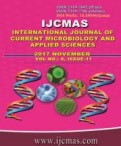


 National Academy of Agricultural Sciences (NAAS)
National Academy of Agricultural Sciences (NAAS)

|
PRINT ISSN : 2319-7692
Online ISSN : 2319-7706 Issues : 12 per year Publisher : Excellent Publishers Email : editorijcmas@gmail.com / submit@ijcmas.com Editor-in-chief: Dr.M.Prakash Index Copernicus ICV 2018: 95.39 NAAS RATING 2020: 5.38 |
Daily rainfall data of one hundred fifteen years (1901-2015) have been analyzed for establishing the long term averages of nakshatra-wise, monthly, seasonal and annual rainfall and its variability. The overall mean annual rainfall at Bidar region was 930.4 mm and distribution of 730.2 mm, 113.8 mm, 72.8 mm and 21.1 mm in monsoon, post monsoon, summer and winter respectively. The coefficient of variation of 26.6 indicated that rainfall was more or less stable over the years. July month receives maximum mean rainfall of 206.6 mm and contributed 22.2 per cent followed by September (201.4 mm, contributed 21.6 per cent). There is an ample scope for rain water harvesting from July to September which can be utilized as crop saving irrigation as well as pre sowing irrigation for succeeding Rabi crops which are generally sown on residual soil moisture. According to 'Nakshatras', the traditional system of rainfall distribution for agriculture, revealed that the period from Punarvasu to Swati which covers the monsoon and post monsoon period received good amount of rainfall during which crops like Sugarcane, Maize, Bajra and pulses like Greengram, Blackgram, Soybean, Redgram can be taken up during monsoon and chick pea, Rabi sorghum, safflower can be taken up during post monsoon.
 |
 |
 |
 |
 |